|
On Saturday, June 3, 1967, the 1964-1965
New York World's Fair Corporation returned the restored park,
now called Flushing Meadows-Corona Park, to the Parks Department
and the City of New York. The Fair had occupied the park for
seven years. Even though the promised $50 million in funds for
restoration and improvements did not materialize as a result
of the Fair, Robert Moses was able to realize part of his dream
of a great urban park in mid-Queens; for Flushing Meadows was
much improved because of the second great fair to be held there.
In ceremonies that day, Moses said:
|
-
Robert Moses (front
chair) at the ceremonies returning Flushing Meadows-Corona Park
back to the City. (Photo courtesy of Gary Holmes)
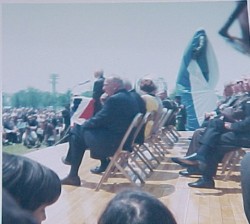 |
"Guard
it well, Mr. Mayor and Mr. Parks Commissioner. It has echoed
to the sounds of many footsteps and voices. The world has beaten
a path to its doors. Now we return it to the natives."
Robert Moses
June 3, 1967
|
|
-
Source: Flushing
Meadows-Corona Park Public Ceremonies Commemorative Book
|
Beauty
for Ashes

A Statement
by the Executive Committee
of the
New York
World's Fair 1964-1965
IN RETURNING custody
of Flushing Meadows-Corona Park to Mayor John V. Lindsay and
Commissioner August Heckscher of the City Department of Parks
today, we chronicle three decades of unremitting effort to create
for the City a modern,centrally located family park on what once
was the domain of the Brooklyn Ash Removal Company.
The transformation
of a monstrous ash dump into a fully equipped 1,258-acre park
has been no easy task. It has taken more than thirty years to
accomplish our goal.
To the legacies of
two World's Fairs and a temporary World Capitol have been added,
by the cooperation of many agencies, and interests, many new
features described in the following pages. Other facilities can
be added as the surrounding population grows and new funds become
available.
We have sought, in
the words of Isaiah, to give the City "beauty for ashes."
EXECUTIVE COMMITTEE
-
Thomas J.
Deegan, Jr.
-
Chairman
|
Remember the Fair?
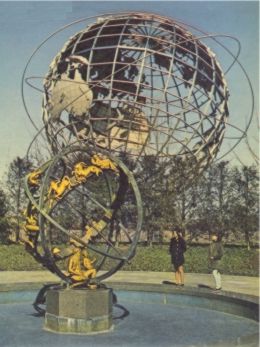 |
"Remember the Fair?" who could forget
it? Especially when it includes the symbolic Unisphere, built
by United States Steel for the 1964-1965 New York World's Fair,
and another piece of Fair sculpture, the bronze armillary sphere
and sundial, embellished in gold with signs of the zodiac, by
Paul Manship. It stands in Manship Pool in New Amsterdam Plaza,
which is in front of the New York City Building. That structure,
fairgoers may recall, was built for the first New York World's
Fair in 1939-1940 and used in both fairs.
Now the fairgrounds have been transformed
into a family park, as promised by Robert Moses. Officially named
Flushing Meadows-Corona Park, it will be formally opened to the
public June 3.
|
familiar surroundings
World's Fair site scene of varied
activities and planned improvements
|
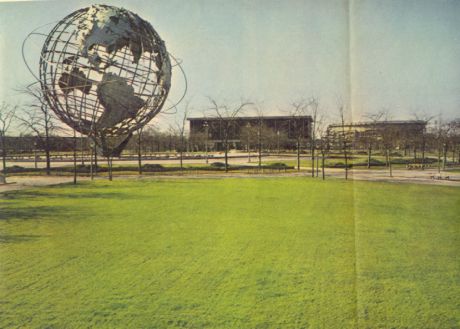
Lots of lawn green on the former fairgrounds nowadays!
You're looking northwest from the Africa pavilion area.
|
|
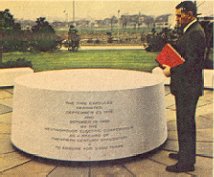
Phillip Norton views granite marker for 1938 and 1965
Westinghouse Time Capsules to be opened in 5,000 years.
|
Look at the pictures ... See some familiar
landmarks? You sure do if you were among the 51 million people
who went to the New York World's Fair of 1964-65. This is how
your old stomping grounds look in the spring of 1967. Study the
colorfotos of the wide open spaces for a while and try to remember
what pavilions and exhibits once stood where, now green grass
grows all around. Find it kind of tough?
Today the place is a family park that goes
by the official long-handled name of Flushing Meadows-Corona
Park. Its opening is a promise redeemed by Fair President Robert
Moses, who has long envisioned this meadow area of Queens as
a permanent park dedicated to the pleasure of the public.
|
|
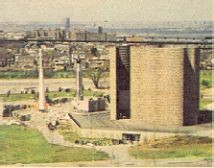
The Space Park and Hall of Science, holdovers from
the Fair, look like this from the Top of the Fair Heliport.
|
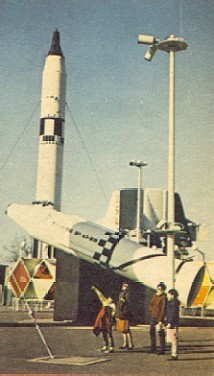
This one looks as if the Fair never moved out! It is,
of course, the Space Park, and it's still loaded with rocketry.
|
|
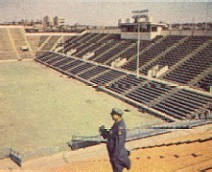
Capt. Fred Miller of security guards surveys the Arena,
formerly Singer Bowl. It will be for special events, too.
|
|
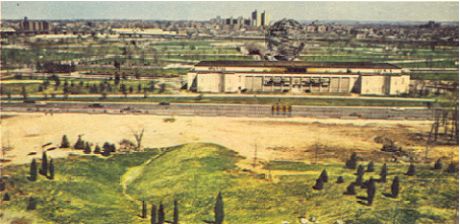
Chrysler et al once occupied area east of the Heliport.
Now it is being prepared for a zoo and an animal range.
|
|
PARKS ARE DESIGNED for recreational activity
as well as for simple rest areas set amid natural greenery. Such
is the case with the brand new Flushing Meadows-Corona Park developed
on the site of New York's two world's fairs.
The activities available now, in preparation
or on the planning board are many and varied. In addition to
the Hall of Science, Space Park and planned zoo, all noted in
the centerfold, this Queens family park offers swimming, fishing,
boating, ice-skating, baseball and softball diamonds, basketball,
boccie and handball courts, small fry playgrounds, a model planes
airport, a pitch-putt golf course, athletic contests, band concerts,
flower and plant exhibits and numerous special events. And don't
forget adjacent Shea Stadium and the Flushing Bay Marina. Last,
and most essential are plenty of eating facilities, picnic areas
and comfort stations.
|
|
|
|
|
Boccie players enjoy game on site of Fair's Auto Thrill
Show. N.Y. State's observation towers (rear) are open.
|
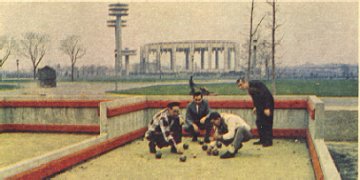
|
|
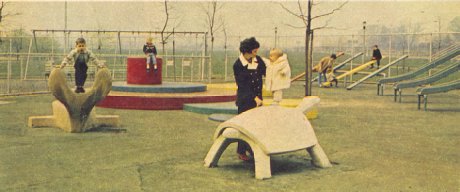
Mothers supervise their youngsters on one of
the large playgrounds. City's Dept. of Parks operates the new
park.
|
|
Joe Tardi, John O'Neill and Arthur Kiviette (l.
to r.) play pitch-putt where Mormon and Gas pavilions once stood.
|
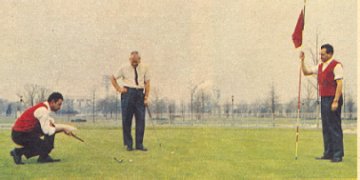
|
-
Source: New
York Sunday News, June 4, 1967
-
Photos:
NEWS Colorfotos by William Klein and Patrick Carroll
-
-
The wild, wild East
|
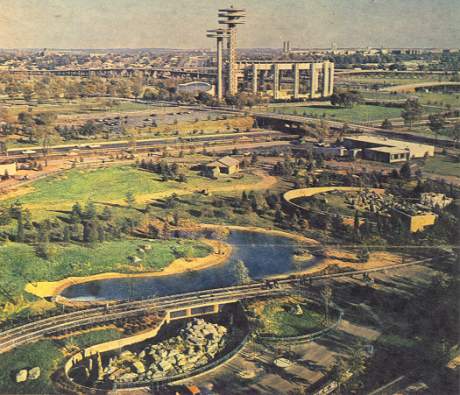
The Queens Zoo covers 18 acres on site formerly occupied
by World's Fair. In background is N.Y. State Pavilion.
|
|
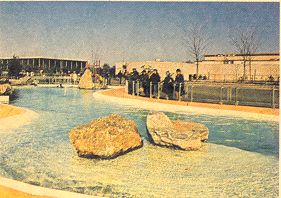
The sea lion pool was constructed to conform as closely
as possible with fun-loving animals' natural element.
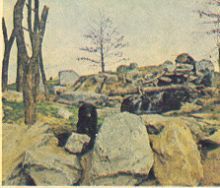
The bear den seems to be carved out of bruins' normal
habitat. Zoo was designed to eliminate bars and cages.
|
IT TOOK 185 years for it to happen, but the
borough of Queens can finally boast its own zoo. (Every other
borough has had one for years.) The animal and bird sanctuary
covers 18 acres of land occupied by two world's fairs.
The Queens Zoo, which officially opened on
Oct. 26, cost $3.5 million. It adjoins the Children's Zoo, which
threw open its doors last February. Most of the creatures on
exhibit are housed in setting closely approximating their natural
habitats. The zoo, which is located in the Flushing Meadows-Corona
park, also features an insect house and a landscaped aviary.
Admission to the new modern and spacious Queens
Zoo is free. It is open to the public every day of the week from
10 a.m. to 4 p.m., and can easily be reached by taking the IRT
Flushing subway line's local to the 111th Street station.
|
|
The popular Heckscher Children's Zoo adjoins the
new Queens Zoo. It came into existence on Feb. 28, 1968.
|
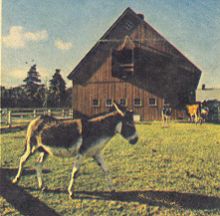
|
|
Mrs. Patianna
Gillette-Infante, the
supervising menagerie keeper, makes friends with one of the deer
at the zoo..
|
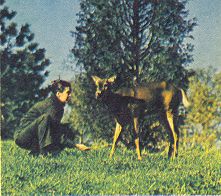
|
-
-
Source: New
York Sunday News, December 29, 1968
-
Photos:
NEWS Colorfotos by Robert Koller and Patrick Carroll
-
-
-
A Failed Plan
|
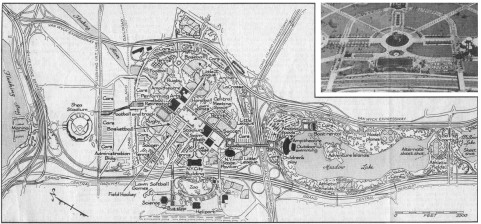
TIVOLI IN NEW YORK: Map
of the park planned for Flushing Meadows on site of the 1964-65
World's Fair. Photo shows park today, with New York City Building
in foreground.
|
Flushing Meadows Park Plan Delayed
By ADA LOUISE HUXTABLE
|
A plan for Flushing Meadows Park by a prize-winning
international design team is being delayed because the City Controller's
office is refusing payment for the first stage of the work, pending
required investigation of the architects' contracts and status.
The problem began last October, when the Parks
Department, eager to acquire the best architectural talent available,
hired the three architects without coordinating with the Controller's
office. As a result, the necessary, but belated, investigation
has forced the project to a standstill.
The payments are being held up because two
of the celebrated architects are not registered in this state;
a quibble about whether work by a landscape architects is architecture
rather than landscape architecture and the auditing of bills
by the Controller's office for "reasonableness."
Planners who have seen the design for the
old World's Fair site call it a breakthrough. They believe that
it is as important for New York in the 20th century as Olmsted's
Central Park was in the 19th century.
The architects for the project are Marcel,
Breuer & Associates of New York and Kenzo Tange of Tokyo,
and the landscape architects are Lawrence Halprin & Associates
of San Francisco.
The Park Department's action in hiring the
architects last fall was the first here to offer increased fees
and a more encouraging climate toward innovation by top architects.
As a result, the city has begun to attract architects of outstanding
reputation, among them Philip Johnson and Paul Rudolph. The city
has also been experimenting with designs by young talent for
parks and playgrounds.
The Flushing Meadows plan stresses activities
rather than a pastoral quality. This form was chosen in response
to the results of a survey of the needs of New York's most underprivileged
areas. These needs go beyond the scarcity of open green space
to the lack of recreational programs and facilities.
In an attempt to fill these requirements,
the plan proposes a combination of landscaping and building for
sports, entertainment and culture on every level from drag racing
to little theater and picnicking.
|
There was some confusion yesterday about whether
two famous structures of the World's Fair -- the Unisphere and
the Federal Building -- would remain in the park. They were not
on the tentative plan. The architects were out of town and could
not be reached and their assistants warned against assuming that
the absence of those buildings was an oversight. But Park Commissioner
August Heckscher said that so far as he knew, the buildings would
stay.
If the project proceeds into its final stages,
it will provide outdoor playfields, indoor courts and an arts
center. There will be a series of "adventure islands"
in the existing lagoons. Some noisy activities would be sunk
into landscaped earth "berms," in which protecting
grassy slopes are raised at the edge of depressed playing fields.
Centered on Plaza
"Spines" of restaurants, eating
bars, shops and concessions would connect buildings and outdoor
activity areas. All would focus on a landscaped plaza, or central
meeting place. The facilities would be intended for all-year,
day and night use.
Mr. Breuer and Mr. Tange are working on designs
for buildings for recreational and cultural activities within
this scheme, as well as a swim-bath and sport stadium. Preliminary
possibilities being studied for the site include ball games of
all kinds, tennis, track, ice hockey, bowling, billiards, boxing,
wrestling, judo, movies, theater, television and a discotheque.
To speed the job, design was begun on the
park plan in January, three months after the announcement of
the project. Work proceeded while the contracts were being prepared
and the Corporation Counsel's office checked them. They were
signed in May and registered by the Controller's office.
By this time, the architects had already finished
six month's work, which included the first phase of the job,
site programing and design. They are now well into the second
phase, actual building design. And, despite the money problem,
all three men are meeting in Tokyo this week to continue their
collaboration on the park.
Even after the plans are approved and paid
for, the project must get approval from other city agencies before
the work can be carried on.
|
-
-
Source: New
York Times, August 12, 1967 (Excerpted)
-
Photos:
NEWS Colorfotos by William Klein and Patrick Carroll
|